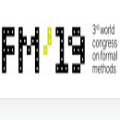Towards spin selective electronics made of three coordinated carbon atoms, here we computationally propose robust and reversibly bias driven evolution of pristine undoped graphene nano-ribbons(GNR) into ferromagnetic-semiconductor, metal or a half metal, irrespective of their edge configurations. The evolution is a result of a rare ferromagnetic(FM) order emerging among nearest neighbouring(n-n) sites, in positively biased regions in their in-homogeneous bias unit-cells, in attempt to cooperatively minimise on-site Coulomb repulsion and kinetic energy, while maximising localization of electrons at the positively biased sites. The phenomenon appears to be a general property of in-homogeneously biased Coulomb correlated bipartite systems. Consequences are particularly rich in zigzag edged graphene nano-ribbons(ZGNR) due to the contest of bias driven n-n FM order and the inter-edge antiferromagnetic order inherent to ZGNRs, leading to systematic closing of gap for one of the spins, amounting to bias controlled unmissable opening of window for FM-semiconducting and half-metallic transport.
翻译:由三个协调的碳原子组成的选择性电子旋转,在这里,我们计算,我们提出由三个协调的碳原子制成的选择性电子,以稳健和不可逆转的偏向为主的偏差推动,将纯离离的石墨纳米核子(GNR)纳米核子(GNR)转化为铁磁半导体、金属或半金属,而不管其边缘配置如何。这种演进是由于最近的邻近(n-n)地点之间出现了稀有的铁磁(FM)秩序,位于偏差偏差的区域,它们位于同源的偏差偏差偏差偏差的单元细胞中,试图合作最大限度地减少现场的库伦反振动能和动能,同时在偏差的场所实现电子的优化本地化。这种现象似乎是热热偏差偏差的库伦相关两边系统的一般特性。结果特别丰富,因为对偏差偏差的n-n-mmy-ribons(ZGNRR)秩序和ZGNR内隐含的顶尖抗磁性反磁性秩序进行竞争,导致系统缩小导半导导的M式半导窗口的裂裂缝裂缝裂。




